When I first encountered Coprinopsis lagopus, an Inky Cap mushroom, growing here, I wasn’t actually sure it was a mushroom at all. This is one of the most fragile appearing species of fungus, of any, I’ve seen this winter. In the past week numerous specimens of this mushroom have been found all over the property, in various stages of growth.
Coprinopsis lagopus is commonly known as the ‘Haresfoot Inky Cap’ as the young fruiting bodies vaguely resemble a rabbit’s foot.
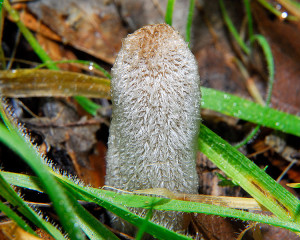
Young, dry, fruiting bodies of Coprinopsis lagopus are quite fuzzy, and vaguely resemble a rabbit's foot
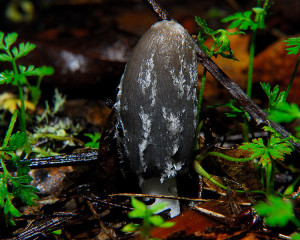
However, note that when wet the fine hairs are less visible on the surface, exposing the cuticle beneath
Coprinopsis lagopus decomposes woody debris in forests, is very common, and can be found worldwide. It is also occasionally found in cultivated gardens growing on wood chips. Even here it seems this species favors our numerous scattered piles of decomposing woodchips that we’ve generated since acquiring ‘Wally’.
When young, the cap of Coprinopsis lagopus is conical in shape, and the surface is covered with soft, white hairs which are remnants of a universal veil. As the cap opens, it becomes more plane, and is typically 3-6 cm broad.
In maturity the margin recurves. The mature fruiting bodies are short lived, and begin to decay in a matter of hours. The veil remnants usually weather away, and reveal a striate greyish-brown cuticle, with papery thin flesh.
The edges of the margin are often split or ragged in age as the gills liquefy. The liquefaction of the gills is an intriguing method of exposing the spores to the wind to aid in their dispersal. The gills liquefy from the bottom up as the spores are maturing, causing the cap to peel up and away, exposing the spores to air currents.
The spores are violaceous black. As the cap liquefies it results in the ink that provides the common name for these inky caps. This “ink” can apparently be used as writing ink, although I admit I haven’t tried.
The stipe is 2-10 cm tall, hollow, fragile, and covered in white veil fragments especially toward the base when young, but may become smooth with age.
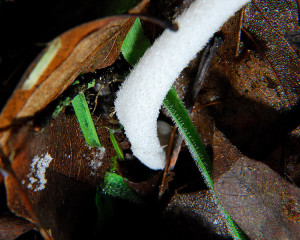
The base of the stipe can remain quite 'fuzzy' as this mushroom matures, as seen here, or may become smooth
The edibility of this species is unknown.
This species demonstrates that identification of some fungi can be rather challenging if all the life-stages have not been observed. I initially located just the single specimen shown in the first photograph, along with a few cap-less collapsed stems. It wasn’t until a small gregariously clustered group of these fungi, in various stages of growth were found, that I could more accurately determine what I was looking at.


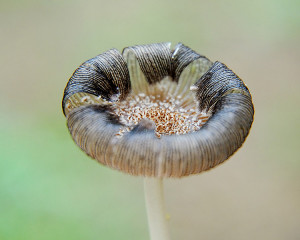
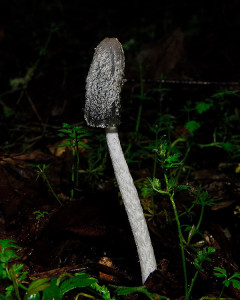

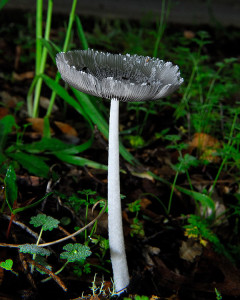
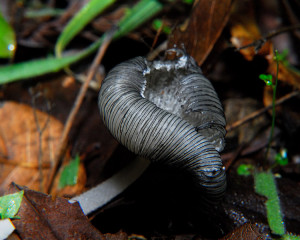

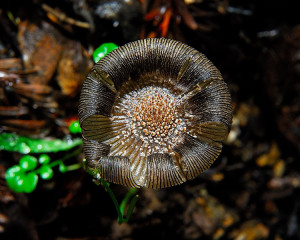
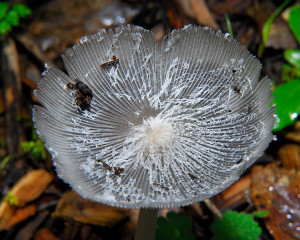
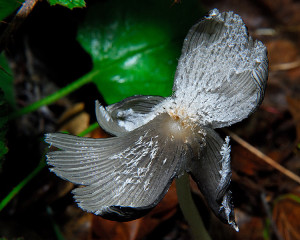
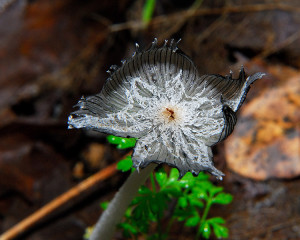
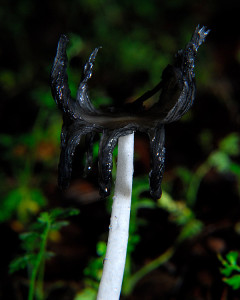







Dear CV, You really do have such an impressive knowledge of fungi and clearly are adept at identifying different varieties. I do admire this as I know for myself that if I came across anything like any of these I should be tempted to leave well alone.
In the Budapest markets many different types of mushroom are offered for sale but I imagine that the stallholders do know what they are selling. Anyway, I very much hope so!
I do have fun trying to figure out all the mushroom species we have growing here, but I’m no expert. As such, I only ‘hunt’ mushrooms with my camera. Even the Chanterelles I posted last week I left alone in the ground. There are too many look-alike species for some of the mushrooms, and I’d hate to make a mistake. I’ll leave harvesting for the real experts!
We did find some lovely sausage made with black trumpet chanterelles (that I posted about last week) at our local farmers market on Saturday though, so I can honestly say we’ve now tried the black trumpets, but never would eat the mushrooms we find randomly growing here.
These shrooms are awesome…amazing photos! I have to admit that the hairy one gives me the creeps, but the dainty one with recurving umbrella cap is quite sweet. Nice post!
CV, do you mind if I ask how you are identifying all of these species that you find on your property? The reason I ask is that I’m considering investing in a really good mushroom field guide, and wonder if you have a recommendation. 🙂
Once again, a great post and a fascinating glimpse into the world of fungi. This one is so delicate and its forms so varied, I can see why it would be tricky to spot and identify.
I don’t think there is any one brilliant book for identifying mushrooms. Many books are out of date now as numerous species are being reclassified genetically. All the books are incomplete. I now mostly use online resources, and consult with some ‘professional’ mushroom hunters through an online forum that’s geared toward California fungi.
Online, I recommend:
http://www.mushroomexpert.com/
This is the most comprehensive site I’ve found, that pertains to mushrooms across the US, and has more than 800 ‘Keys’ to mushroom species.
I also use (more CA specific):
http://www.mykoweb.com/
http://www.mushroomobserver.org/
For this mushroom, I had no idea where to start, so I asked the font of infinite knowledge for help, aka Google. If you Google “grey mushroom wood chips cap paper thin” the first hit is ‘Inky Caps’ at MushroomExpert.com. Google can sometimes be helpful for narrowing down possible species, as you can switch to the images tab when you search, and browse to see if you find something similar to your mushroom of interest. Then once you have an idea or two of potential Genus, you can look for more detail at MushroomExpert to confirm or refute your ID.
Check your local library too, to see if anyone has published a local text covering species for your area.
Local fungus fairs, often held mid-winter, are an excellent place to familiarize yourself with the various genera of mushrooms that grow in your region. There you can see them up close, and in 3D…much better than any book in press! 😀
Coprinopsis/Coprinus lagopus is a mushroom that also grows in abundance in our garden.
And it’s stunning, how your pictures of this mushroom ressemble mine
This picture is called just ‘hazenpootje’, harefoot, in Dutch. We don’t even mention that it’s an inky cap…
You’re right, that it’s not always easy to identify this species. I have seen it for many years in my garden now, and last fall there was one, that I was completely sure it was NOT a haresfoot, and eventually turned out it was one indeed.
(I have a blogpost about this mushroom too, but it dates back from the time I didn’t translate my texts yet.)
I love seeing mushrooms in the wild. I’m a pretty big hiker and seeing some of these delicate creatures in all kinds of colors and shapes is one of the things I seek out. I have no expertise though, and consider all of them to be poisonous just to be on the safe side!
Mushrooms are one thing I know almost nothing about so I’ve found these posts really interesting. And your photography is excellent.
What amazing creatures you show us… it is hard to believe they are all the same mushroom. One can see why it is call Inky Cap! As always your photos are stunning and so educational. ;>)
Wow, I’ve never seen the “hare’s foot” stage. Awesome!
I’ve got some photos of these mushrooms:
http://howsrobb.blogspot.com/2008/11/to-fair.html